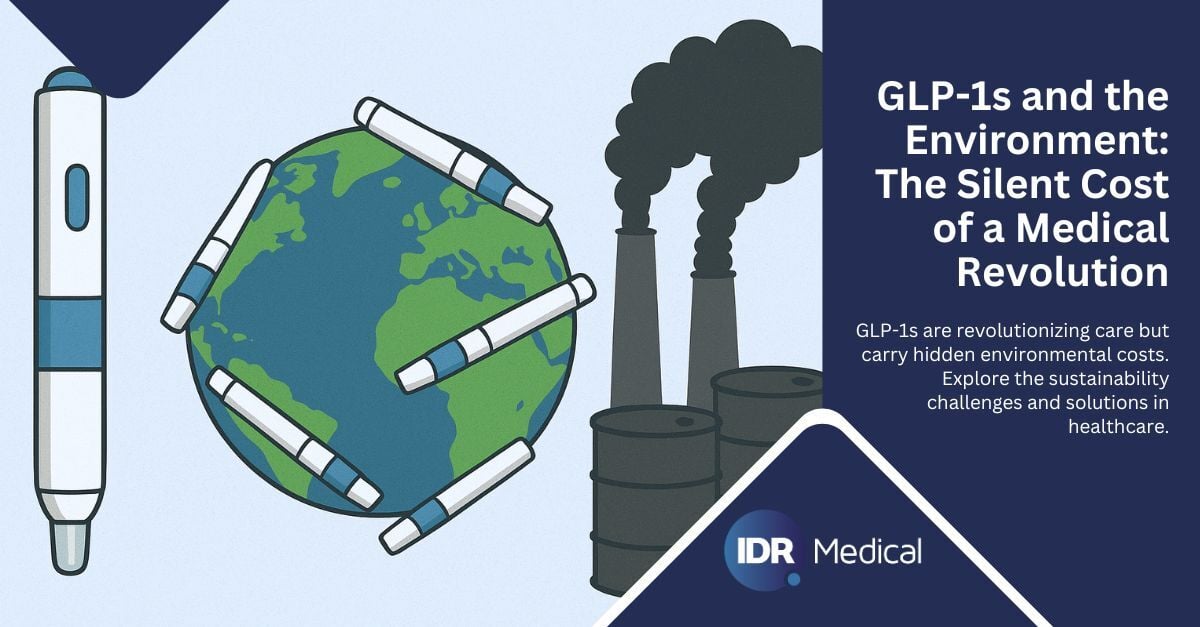Switzerland (Head Quarters)
IDR Medical Switzerland
Austrasse 95, CH-4051 Basel, Switzerland
T:
+41 (0) 61 535 1109
UK
IDR Medical UK
Unit 104 Eagle Tower, Eagle Tower
Montpellier Drive, Cheltenham, GL50 1TA
T:
+44 (0) 1242 696 790
USA
IDR Medical North America
225 Franklin Street, 26th Floor
Boston, Massachusetts 02110, USA
T:
+1 (0) 617.275.4465

GLP-1s and the Environment: The Silent Cost of a Medical Revolution
GLP-1 receptor agonists have become the breakout therapy of the decade. Once targeted at diabetes, they are now fueling a global shift in obesity treatment, transforming lives and creating a multi-billion dollar market.
But behind the clinical success story lies an inconvenient truth: GLP-1s are among the most environmentally costly drugs ever scaled. Their manufacturing, packaging, delivery, and disposal leave a heavy footprint that healthcare systems cannot afford to ignore if they are serious about net-zero commitments.
1. GLP-1 Manufacturing and Supply Chain: The Hidden Sustainability Costs
GLP-1s are not simple pills; they are synthetic peptides built through complex multi-step chemistry. This makes them resource-intensive and waste-heavy:
- Low yield, high discard – peptide synthesis often requires large quantities of raw materials and solvents, yet only a fraction becomes usable drug. The rest is chemical waste requiring energy-intensive disposal.
- Purification burden – multiple chromatography steps consume vast amounts of water and electricity.
- Cold chain dependency – every unit must be refrigerated from factory to pharmacy shelf, multiplying emissions across the supply chain.
2. Single-Use GLP-1 Injection Devices: A Growing Sustainability Challenge
Most GLP-1s are delivered via single-use injection pens. Designed for ease of use, they are an environmental headache:
- Plastic and mixed materials – each pen combines plastic, metal, and glass, making recycling nearly impossible.
- Needle disposal – millions of sharps enter the waste stream annually, with many health systems lacking safe collection schemes.
- Secondary packaging – trays, cartons, and leaflets add further volume to the waste stream.
The scale matters: as GLP-1 adoption accelerates globally, this translates into hundreds of millions of pens discarded every year.
3. Drug Waste in GLP-1 Delivery Systems: Risks for Healthcare and the Environment
Unlike tablets, expired GLP-1 pens often contain residual active drug. If improperly disposed of, these peptides risk entering landfills or water systems, creating an additional environmental hazard beyond the device itself.
4. GLP-1 Therapies: Balancing Clinical Benefits with Environmental Impact
There is an irony: by tackling obesity and diabetes, GLP-1s could reduce the incidence of cardiovascular disease, kidney failure, and other conditions each of which carries a heavy environmental cost through surgeries, hospitalizations, and long-term drug use.
But unless manufacturing and delivery evolve, the environmental gains from healthier populations could be offset by the waste created to get there.
5. Sustainability Solutions for GLP-1 Delivery and Beyond
GLP-1s are not going away. Prescriptions are set to grow exponentially. The challenge is ensuring innovation in sustainability keeps pace with demand. Solutions exist:
- Oral formulations – already available, they eliminate injection-related waste.
- Reusable injectors – cartridge-based systems could slash single-use plastic.
- Circular recycling – manufacturer-led take-back schemes for pens and needles must become standard.
- Green chemistry – improved peptide synthesis and purification methods can reduce chemical waste and energy use.
- Policy pressure – regulators and payers should begin to evaluate drugs not only on efficacy and cost, but also on their sustainability profile.
💡 “Executives who align devices with sustainability will not just reduce waste, they will create a powerful competitive differentiator in a crowded GLP-1 market.”
GLP-1: A Defining Test Case for Healthcare Sustainability and Innovation
GLP-1s represent a once-in-a-generation breakthrough. But their environmental cost risks becoming a defining blind spot for an industry that has pledged to decarbonize.
The question for executives and policymakers is simple:
- Will GLP-1s be remembered as a symbol of medical progress, or as the therapy that forced healthcare to reckon with the hidden costs of innovation?
🌍 At IDR Medical, we help healthcare leaders navigate these challenges. By uncovering patient and clinician perspectives on sustainability, and testing adoption pathways for greener alternatives, our research delivers the insights needed to drive smarter innovation and strategy.
📊 If your organization is exploring sustainable delivery models for GLP-1s or other high-impact therapies, we’d love to collaborate. Together, we can ensure that medical progress and environmental responsibility move forward hand-in-hand.
👉 Connect with IDR Medical to see how research can support your strategy.


